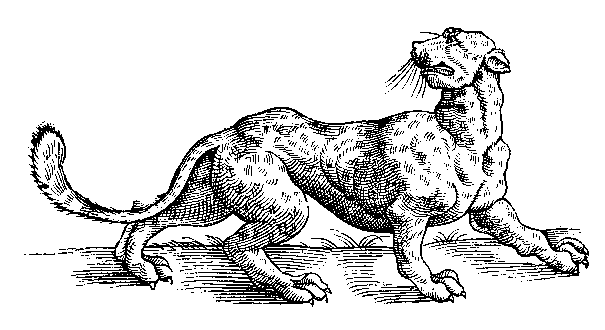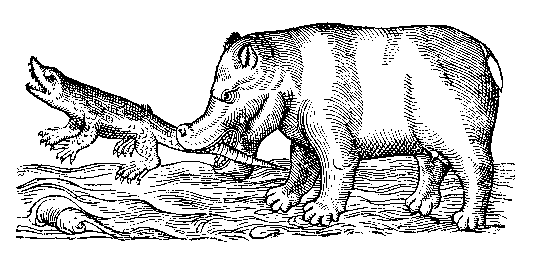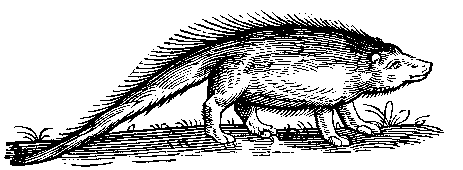

Definately one of my favourite illustrations from Topsel.
One of the more curious abilities attributed to Panthers, is that they are able to attract their prey by belching., as Anne Clark notes in Beasts and Bawdy: �the panther... emits a loud belch, which smells so sweet that it draws all animals after him.� (she goes on to note that this ability is also attributed to Jesus Christ, but we won�t bother with that here.) Topsel puts it a little more delicately. �Panthers by their sweet smells draw the Beasts unto them and destroy them.� It is not only the Panther�s smell which is wonderful, but his general appearance. Goats, Hares, Roes, Hindes, and all manner of other beasts are so �mightily delighted with his spotted skin and fragrant smell, that they will always come running unto him from all parts.� Unfortunately the Panther�s face is much less attractive, so he keeps that turned away from his prey.
At around 120,000 words, the section on Horses is the longest in Topsel�s History. Nestled in the middle of it is half a page on the Sea-Horse. Topsell intended to reserve the bulk of his Sea-Horse discourse for his volume on Fishes, which he never got around to.
The Sea-Horse �is a most ugly and filthy Beast�, living �for the most part in the Nilus�, where it devours 'whatsoever cometh in the way� - as can be seen from the picture below, which Topsel found in a volume in The Vatican.

A Crocodile comes in the way of a Sea-Horse.
(By Topsel's time, Europeans had improved considerably at rendering Crocodiles. Click here to see a 12th century Crocodile.)

I�ll come clean with you. I really don't know what an Ichneumon is. I think it's clear though that Topsel is trying to describe some sort of terrestrial creature. I�m just not certain which one. The Ichneumon lives in the water, and is thought to be a type of Otter (or the Otter is a type of Ichnuemon.) It eats Crocodile eggs, has bristles instead of hair, and lives only in Egypt (Egypt, it should be noted, has been the repository of a great many unusual creatures, since at least the days of Herodotus.) update: according to my Finnish Friend the Ichneumon "is actually a kind of Mongoose. Egyptians thought it was sacred because it ate snakes and croc eggs. It is a small carnivore, very distantly related to cats." (9/2006)

An older picture of the Ichneumon, by Bellonius. Topsel notes 'the back is too elevated�
The Ichneumon�s most notable physical attribute, writes Topsel, is 'a large passage, compassed about with hair, on the outside of his excrement hole like the genital of a woman, which it never openeth but in extremity of heat;. The Ichneumon can hold his breath longer than any other four-footed beast. It is a 'valiant and nimble creature', and if swallowed by a crocodile, he will 'deliver himself forth, by eating through the bowels.' This unwelcome act causes the Crocodile to �runneth to and fro�.
The Lion is justly titled by all writers the King of Beasts, but Topsel�s introduction to his section on Lions is a little odd. Recalling the proverb of the Ass, which was torn in pieces by a Lion for failing to portion out a large enough share of meat to him, Topsel says that he had better give the Lion an extra big section in his book, lest he be set upon by �illiterate and envious men, (who)... would censure me with as great severity, if I should, like an Asse, forget my self.� Hmmm... what�s he up to with this move?

�There is a beast called Leontophonus, a little creature in Syria�, and should a Lion eat this beast, he will die on the spot. Hunters scatter the ashes of the Leontophonus (or �lion-queller�) onto the carcasses of other animals, and even this is sufficient to slay the Lion. Even the urine of this beast, sprinkled upon a Lion �doth wonderfully harm him, if it doth not destroy him.� For this reason, �the Lion does not undeservedly hate it, and when she findeth it, although she dare not touch it with her teeth, yet she teareth it to pieces with her claws.�
Lions have outstanding eyesight, and 'their smelling... is very eminent�, and �if the Lionesse have committed adultery with the Leopard, the male discovereth it by the sense of his Nose�. Apparently this fondness of Lionesses for Leopards is quite widespread, but the male only punishes her �if she wash not herself before she come at him.� The libidinousness of the Lioness is considerable. �There is no Beast more desirous of copulation than a Lioness.� (Topsel seems to be forgetting that he has already said the same thing about Mares, and more than a few other females of various species (though notably not the Hinde, who will generally �run away�from the sex-crazed Hart, �if they can�.)
The Linx was traditionally thought to be a hybrid of a Wolf and Hind, but Topsel points out that �Beasts of such hostility, and adverse dispositions in nature�, were not all that likely to �suffer copulation�. Topsel thinks it likely that the Linx is a type of Cat, but brushes the issue aside somewhat, by saying �it shall be idle to spend time about disputation to what rank or order every beast ought to be referred.� Heretical as that may seem from a modern perspective, I think there�s a kernel of wisdom lurking in Topsel�s assertion. Something about missing the woods for the trees...

A Linx pursuing a wilde cat, copied from Magnus�s encyclopedia.
Linx�s are thought to have the keenest eyesight of any beast. Topsel notes that �the Poets saign that their eye sight pierceth through every solid body, although it be as thick as a wall; yet if you offer unto it any thing which is transparent, it is much offended�.

�It hath been falsely believed�, writes Topsel, �that all Tigers be females�, and that they �conceiveth with young by the West wind.� Topsel marvels how this fable came up (though he seems not to mind at all when Aristotle makes the same claim about the Mares in Portugal.)
�The Indians say that a Tiger is bigger than the greatest Horse, and that for strength and swiftness they excel all other Beasts.� A Tiger has even been seen to �fly upon the head of an Elephant, and devour it�.
One of my favourite moments in Topsel�s book concerns the Tiger.
�..the Tiger, the Indians say can never be conquered, because when he is hunted he runneth away out of sight�
And here endeth the second part of my website on the History of Four-footed Beafts.
Text c. 1998, Tim Gadd
| Topsel main page | |
| 1. Common Beasts | 3. Fantastical Beasts |